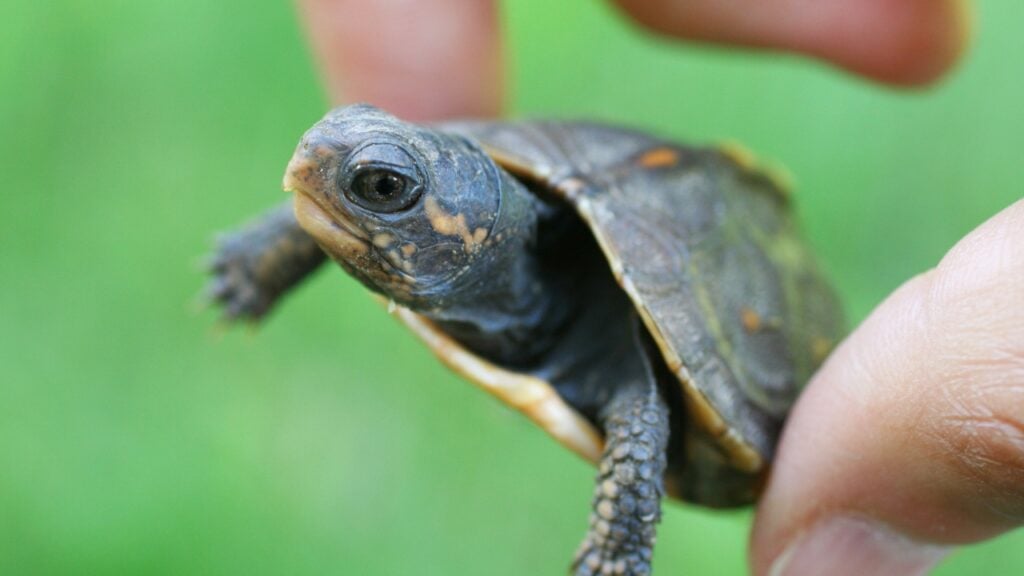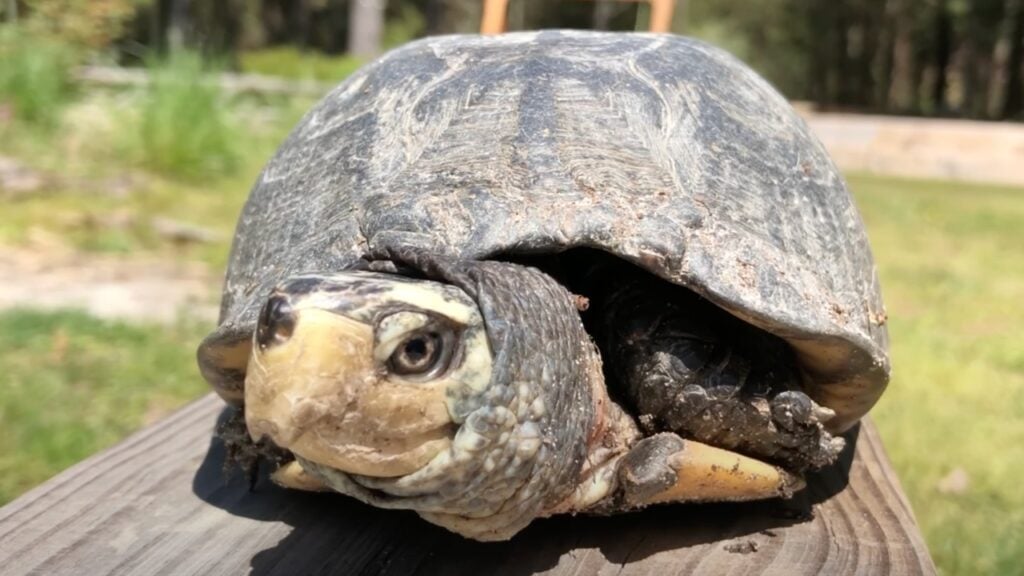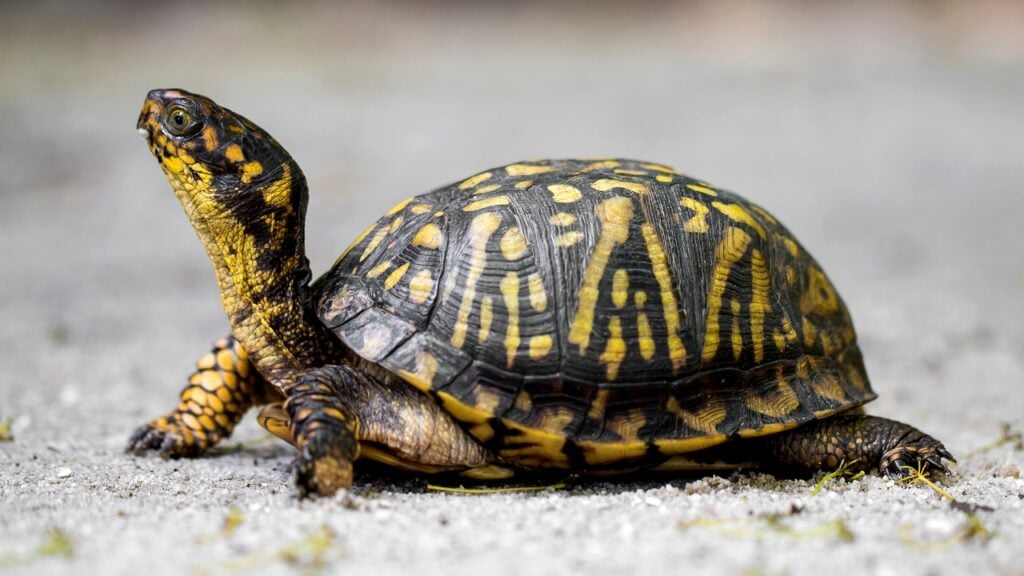
In an ideal world, box turtles prefer to have a large outdoor enclosure where they can get a good supply of sunlight and have plenty of space to roam, explore, bathe, and find bugs and worms to eat.
But, that’s not always practical if you don’t have a large safe garden, live in an apartment block, or live somewhere that is cold most of the year.
Box turtles can happily live indoors as long as they have a large enough enclosure that is set up correctly to meet their needs.
I’ll go through how to choose the ideal indoor box turtle enclosure and how to set up an indoor box turtle habitat correctly.
Ideal Box Turtle Tank Size?
The minimum indoor enclosure size for a single baby box turtle is 36″ x 12″.
The minimum indoor enclosure size for an adult box turtle is 36″ x 18″.
If you have space for something larger your box turtle will really appreciate it, they are inquisitive little guys and love to explore their enclosure.
Make sure the enclosure has high sides or a lid, as they will try to escape and make a run walk for it given half a chance!
Indoor Box Turtle Enclosure Ideas
You have a few options when it comes to choosing a suitable indoor box turtle enclosure, I’ll go through the best options below.
1. Wooden Tortoise House – My No.1 Recommendation
Wooden tortoise enclosures make a great home for box turtles, they have solid sides so that your turtle will feel safe and a private area where they can retreat to and get some rest.
The great thing about the Aivituvin wooden tortoise house is that it has a plastic base, so you don’t have to worry about the bottom of the enclosure rotting due to the high humidity levels that box turtles require.
Another great feature is that you can easily connect 2 of these Aivituvin enclosures together to give your box turtle an awesome home.
2. Plastic Container
Plastic containers or tubs are another great option to house your box turtle, they don’t look as good as the wooden enclosures, but can be more budget-friendly.
One thing to be aware of is that if you buy something super cheap and flimsy, it may melt under the heat lamp.
The Tuff Stuff 40 gallon oval tub is a good sturdy option that’s a great size for an indoor box turtle habitat.
3. Glass Aquarium or Reptile Vivarium
With a little modification, vivariums or aquariums can be a great home for a box turtle, a 40 gallon breeder tank is a great size home for a box turtle.
Because box turtles don’t like to be able to see out of their enclosures you would need to add some blackout film (or similar) to the bottom part of the tank or vivarium, to help them feel safe and secure.
If you don’t black out the bottom part, your box turtle will try to constantly ‘get through’ the glass, which will stress it out.
The downside to glass aquariums or vivariums is that they are generally more expensive unless you can find a second-hand bargain, just be sure to give any second-hand tanks a good cleaning with a bleach solution.
Pet Box Turtle Types
There are many varieties of box turtles, this guide is based on the types that are most commonly kept as pets.
Eastern Box Turtle (Terrapene carolina carolina)

The most popular pet box turtle, also known as the common box turtle or woodland box turtle.
Found in Eastern US in woodland, meadows, and often in backyards.
Male eastern box turtles have distinctive red irises, although females can occasionally have red irises it is much less common.
Males also have much longer and larger hind feet with more colorful scales than females.
They enjoy bathing in shallow water, so they must have a shallow dish of water in their enclosure.
Gulf Coast Box Turtle (Terrapene carolina major)

Gulf turtles are the largest box turtle in North America, they are found in the Florida panhandle and in Mississippi and Louisiana in swampy areas.
Males are known to have white or blue heads, but can occasionally have darker heads.
Gulf coast box turtles also have a distinctive cusped beak (see image above), this is more pronounced in males.
They enjoy being in shallow water, so you must provide them with a shallow dish that they can bathe in.
Due to their larger size, these guys are best suited to a large outdoor enclosure.
Ornate Box Turtle (Terrapene ornata ornata)

Native to central USA in the great plains and can be found in prairies, glades, and woodland.
The ornate box turtle is often confused with the Florida box turtle as they have very similar black shells with yellow lines.
A good way to tell them apart is, the Florida box turtle has a plainer plastron, whereas the ornate box turtle has a beautifully patterned plastron.
Florida box turtles also have 3 toes on their hind feet, whereas ornate box turtles have 4 toes.
As with other box turtles, they require a shallow pool of water for bathing in.
Three-toed Box Turtle (Terrapene carolina triunguis)

Native to south-central USA, these turtles live in wooded areas that have access to water, so you must provide a bathing area for them.
You’d never of guessed this…but these guys get their name from having 3 toes on their hind feet!
They often have a plain brown or tan carapace (shell) and are not as patterned as some other box turtles, although having said that they sometimes have yellow markings on their carapace and males can have yellow, orange, or red markings on their head and neck.
Please don’t take box turtles from the wild to keep as pets, their numbers are declining in many areas.
If you would like a box turtle as a pet, buy one from a reputable breeder or store.
What Do Box Turtles Need in Their Enclosure?
Here is an example image of an ideal indoor setup for a box turtle.
Because box turtles have a resemblance to tortoises many people keep them in the same conditions (hot and dry), not realizing box turtles need water and a humid environment.

Once you have picked an enclosure from the options listed above, it’s now time to find out how to set up an indoor box turtle enclosure correctly and mimic its natural habitat as closely as possible.
Box turtles need plenty of substrate (bedding), a place to hide and feel secure, high humidity levels, a shallow pool of water for bathing, drinking, and cooling off in, and a basking area where they can absorb UVA UVB light and warm up.
Substrate
Box turtles love to bury themselves into the substrate, some of the best choices are:
- Coconut fiber
- Cypress mulch
- Leaf litter
- Organic soil (no pesticides or fertilizer)
- Sphagnum moss
Avoid pine and cedar bark/chips as the oil in them can cause respiratory issues.
The substrate should be damp to keep humidity levels in the correct range (more on this further down), but it should never be wet and soggy.
Provide around 3-4 inches of substrate, depending on the size of your turtle.
Basking Area
A basking area is super important, especially for turtles that are kept indoors and don’t have access to sunlight.
You need to provide a heat and UVA UVB lamp above the basking area.
A basking slate placed directly underneath the heat lamp is a great option to allow your turtle to bask.
It’s super important to monitor the temperature of the basking slate so that it doesn’t get too hot and burn your turtle, equally you don’t want it to be too cold either.
If you see that your turtle is avoiding going on the basking slate, check the temperature.
If you find the basking slate is too hot/cold, gradually increase/decrease the distance between the slate and the heat lamp, until you find the sweet spot (around 85°F / 29°C).
Heat Lamp
Indoor turtles that don’t have access to sunlight need a heat lamp, so they can bask and warm themselves up.
A turtle deprived of heat over a prolonged period will be at risk of:
- Calcium deficiencies
- Depression
- Digestive issues
- Metabolic bone disease
- Respiratory infection
- Shell rot
I’ve done a roundup of the best turtle heat lamps available, my no.1 recommendation is the Zoo Med Aquatic Turtle UVB Heat Lighting Kit, it’s a great all-in-one kit that includes a heat/basking bulb, UVB bulb, and domed light fitting.
UV Lamp
Providing your turtle with a UVA UVB bulb is essential for keeping its bones and shell healthy.
I have done a roundup of the best UVA UVB bulbs available, but again I recommend the Zoo Med kit as it’s super convenient having the UV and heating bulbs, along with the domed light fitting all in one kit.
Lighting Timer
I recommend hooking your UV and heating bulbs up to a light timer, as they only need to be on for around 10-14 hours during the day.
If your turtle is located somewhere where it can get cold at night (below 60°F / 15°C), you can use a ceramic heat emitter bulb instead of a heat lamp.
As it doesn’t give off any light, so it won’t disturb your turtle’s sleep.
Hiding Spot
Box turtles need a place where they can hide away, feel safe, and get some rest.
The wooden tortoise house recommended above has an inbuilt area for your box turtle to escape to and relax, but if you choose a plastic tub or aquarium you’ll need to provide a hiding spot.
You can buy commercially made hideouts like this one. Alternatively, a great free option is an old terracotta plant pot laid on its side, just make sure it’s clean and large enough for your turtle to comfortably fit inside. Hollowed-out logs can work well too, just make sure it’s not a pine or cedar log.
If your box turtle can climb on top of its hiding spot (they love to climb and explore), make sure it’s away from the side of the enclosure so your turtle can’t escape!
Water Area
Although box turtles are land-based, they need an easily accessible large shallow pool of water to drink from and bathe in, you can buy a commercially made one or a sturdy shallow plant pot saucer will work well too.
The water area should be located away from the heat bulb so that the water stays cool.
Change the water daily as your box turtle will pee and poop whilst it’s bathing.
Feeding Area
Provide a small shallow dish for your box turtle’s food. Ensure the food dish is kept free of any substrate to avoid any accidental ingestion.
Box turtles are omnivores and need a diet made up of protein, vegetables, and an occasional treat of fruit.
An adult box turtle’s diet should be around 60% protein and 40% vegetables, with a once-a-week treat of fruit.
Baby box turtles require a higher level of protein (around 80%) to help them grow.
In the wild, box turtles eat bugs, earthworms, crickets, snails, flowers, plants, and much more…they are not fussy eaters!
It can be beneficial to sprinkle their food with a phosphorus-free calcium supplement, to help keep their bones and shell healthy.
Plants For Indoor Box Turtle Habitat

Plants are a great addition to a box turtle enclosure (indoor or outdoor), they look great, provide hiding spots, and can be a tasty and nutritious food source if you choose the right type of plants.
Some of the best edible plants for box turtles are:
- Clover
- Collard Greens
- Parsley
- Strawberry Plants
Humidity Levels
A hygrometer is an essential piece of kit for a box turtle habitat, it measures the humidity levels within the enclosure ensuring they are kept at the correct levels to keep your box turtle healthy.
Box turtles require humidity levels to be around 60-80% depending on the species you have.
Mixing peat moss and/or sphagnum moss in with your substrate is a great way of keeping humidity levels high as they retain water.
Keeping a spray bottle on hand and misting the enclosure when required is an easy way to keep humidity levels correct, without saturating the bedding.
The enclosure should only ever be damp, not wet.
Thermometer
Box turtles are ectotherms and can’t regulate their body temperature by themselves, so you need to provide different temperature zones so they can move around the enclosure to warm up or cool down as needed.
The enclosure should be split into 3 temperature zones:
- Basking area: 85°F (29°C)
- Warm area: 75°F-80°F (24°C-27°C)
- Cool area: 70°F (21°C)
Placing a thermometer at each end of the enclosure is a great way to monitor this.
The hygrometer linked above has an inbuilt thermometer, so it is a great 2-in-1 option, saving you some money.
Laser thermometers are another great option….you can feel like a superhero as you whip out your laser gun and zap an area for a temperature reading (…or is that just me?!! 😂).
Laser thermometers are ideal for checking that the basking slate isn’t too hot/cold and also have lots of other uses around the house.
Indoor Box Turtle Habitat FAQ
Can You Keep A Box Turtle Indoors?
Yes, you can keep a box turtle indoors, as long as you provide a large enough enclosure.
The minimum indoor enclosure size for an adult box turtle is 36 inches x 18 inches and the sides need to be high enough so your turtle can’t escape.
What Kind of Bedding do Box Turtles Need?
Box turtles like deep bedding (substrate) as they love to dig and bury themselves, the bedding should also retain moisture to keep the humidity levels high.
Coconut fiber with some cypress mulch and sphagnum moss makes great bedding for box turtles.
Provide around 3-4 inches of bedding, depending on the size of your turtle.
How Do You Make An Indoor Box Turtle Habitat?
Following the steps above you can make a great indoor box turtle habitat.
Closing Thoughts On How To Set Up An Indoor Box Turtle Habitat…
Now you know how to care for and set up an awesome home for your indoor box turtle and won’t make the mistake of keeping it in the same conditions as a tortoise – I’ve seen SO many people make this mistake and then wonder why their box turtle gets sick!
I have plenty more turtle care guides and product reviews in my turtle section, so be sure to check it out!



















